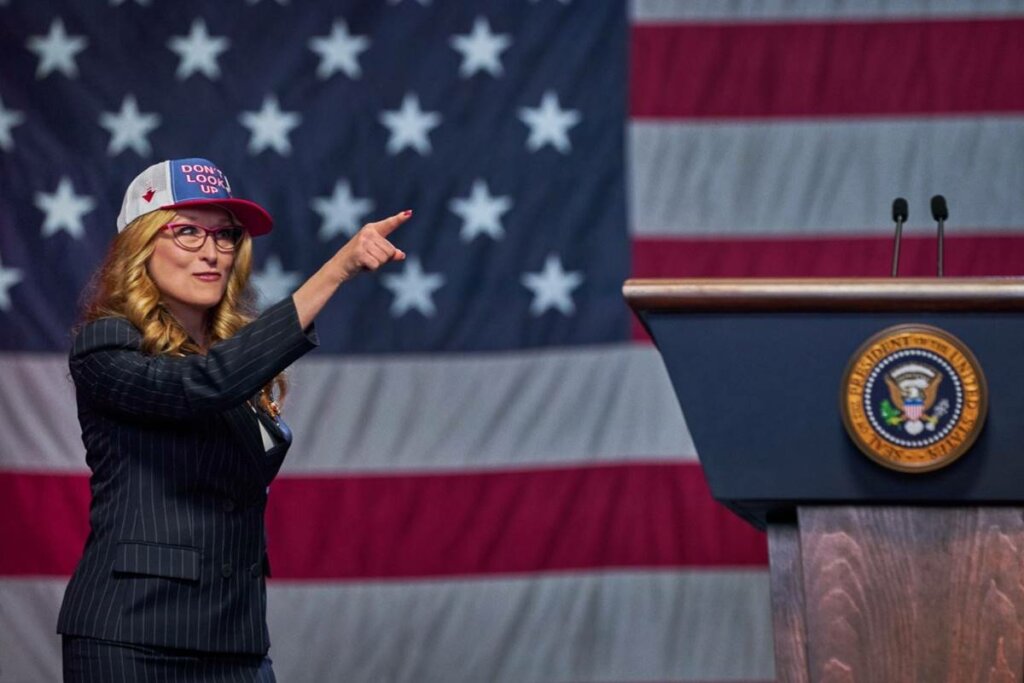Don't Look Up: What if the World Were to End Tomorrow?


Written and verified by the psychologist Valeria Sabater
Don’t Look Up was, for many, an irreverent, chaotic, and even tedious movie. In fact, critics on social media suggested it would’ve been better named “Better Look the Other Way”. Nevertheless, although many viewers started watching it thinking that they wouldn’t even reach the end, they discovered a movie that reflected the political, social, technological, and journalistic reality of our present time in a satirical manner.
This Netflix production was directed by Adam McKay. He came up with the idea for the movie after a conversation with journalist, David Sirota, in 2018.
At this time, the latest report of the Intergovernmental Panel on Climate Change ( IPCC) had just been published. It specified the devastation that the expected increase in global warming in the coming years could cause. Both Mckay and Sirota lamented the lack of media coverage about what was (and is) one of the biggest problems on our planet: climate change.
“It’s like an asteroid is going to devastate the planet and no one cares,” suggested Sirota. Instantly, Adam McKay had a clear and definite vision for what his next film would look like.
“When I decided to put myself in the role of this character, I did it because I wanted to take my hat off to the people who dedicate their lives to this issue and who know what they are talking about. The idea is to give them a voice.”
-Leonardo Dicaprio-

Don’t look up: how to tell the world that its end has come
Don’t Look Up has a whole cast of stars, almost a constellation in fact. For instance, there’s Jennifer Lawrence, Leonardo DiCaprio, Meryl Streep, Jonah Hill, Cate Blanchet, and Timothée Chalamet. It isn’t the usual disaster movie, in which the United States and a hero in the purest Bruce Willis style save the world.
The movie industry has always liked to make productions that portray the Earth as under threat. It’s a way of awakening patriotism and leaving viewers with a syrupy feeling of hope. Nevertheless, this isn’t the case here. Because the objective of this movie is none other than to raise our awareness and serve as a reflection of the reality of which we’re all part.
The comet, a metaphor for climate change
Jennifer Lawrence and Leonardo DiCaprio play astronomers, Kate Dibiasky and Randall Mindy. Both have just discovered that, in a few months, a comet will collide with Earth. The threat is real and the consequences will be apocalyptic.
However, when the scientists rush to report to the US government, they find an administration and a president (Meryl Streep) who don’t give any importance to the event. In fact, they choose to look away.
In view of this attitude on the part of the political elite, Kate and Randall choose to go to the media. Their reaction is almost the same. Indeed, the world of television and social media gives no importance to the imminent end of the world. Love affairs of celebrities are more significant.
Don’t Look Up is a veiled allegory in which the comet symbolizes the climate crisis that nobody talks about or wants to see. Humanity isn’t interested in saving the Earth, as we already discovered at the last climate summit in Glasgow. We’re that same society. The one that’s simply chosen to look the other way.
In Don’t Look Up, we see a heterogeneous collection of journalists, politicians, the military, and tech millionaires who are driven by their personal interests instead of acting together to confront a global threat.
The polarized world and the difficulty of broadcasting messages in the era of fake news
The film acidly shows the weight of social media and journalistic misinformation, so evident in our society today. Fake news, memes, questioning the voices of scientists, and the need to have numerous followers outline an all too familiar reality.
In this delusional game of self-parody and tragedy, we witness more archetypes. We see frivolous presidents and leaders, polarized opinions, infotainment politics, QAnon-style conspiracy theory movements, and music stars mobilizing young people.

The power of tech gurus and false hopes
The character who’s key in the resolution of the film is Peter Isherwell, a billionaire in the technology industry. He’s a subtle mixture of Steve Jobs and Elon Musk. We eventually became aware of how this figure acquires greater relevance than the ineffective and frivolous political elite.
Eventually, economic interest prevails. That’s because they discover that the comet harbors tons of minerals within it that could be exploited and from which there’d be great benefits. When they finally choose to face the global threat, their strategies change… And the machinery of disaster begins.
This is a production that reveals the very essence of human narcissism, of our apathy and inaction. The message from its director is clear. We’re unable to deal with global crises. Furthermore, the worst may be yet to come, though we obviously hope not.
All cited sources were thoroughly reviewed by our team to ensure their quality, reliability, currency, and validity. The bibliography of this article was considered reliable and of academic or scientific accuracy.
- González Gaudiano, Édgar J., Meira Cartea, Pablo Á., & Gutiérrez Pérez, José. (2020). ¿Cómo educar sobre la complejidad de la crisis climática? Hacia un currículum de emergencia. Revista mexicana de investigación educativa, 25(87), 843-872. Epub 19 de febrero de 2021. Recuperado en 28 de diciembre de 2021, de http://www.scielo.org.mx/scielo.php?script=sci_arttext&pid=S1405-66662020000400843&lng=es&tlng=es.
This text is provided for informational purposes only and does not replace consultation with a professional. If in doubt, consult your specialist.








